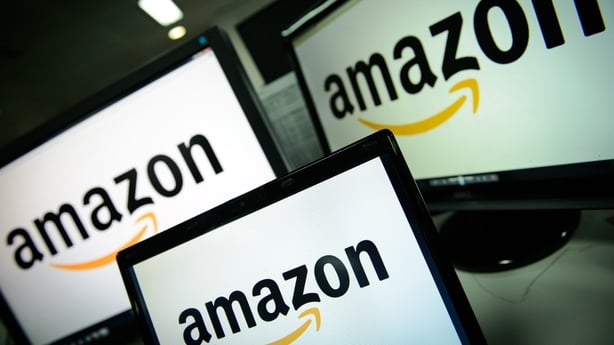Amazon.com's top television shows drew more than 5 million people worldwide to its Prime shopping club by early 2017, according to company documents.
The documents reveal for the first time how the retailer's bet on original video is paying off.
They also show that Amazon's US audience for all video programming on Prime, including films and TV shows it licenses from other companies, was about 26 million customers.
Amazon has never released figures for its total audience.
The internal documents compare metrics that have never been reported for 19 shows exclusive to Amazon: their cost, their viewership and the number of people they helped lure to Prime.
Known as Prime Originals, the shows account for as much as a quarter of what analysts estimate to be total Prime sign-ups from late 2014 to early 2017, the period covered by the documents.
Core to Amazon's strategy is the use of video to convert viewers into shoppers. Fans access Amazon's lineup by joining Prime, a club that includes two-day package delivery and other perks, for an annual fee.
The company declined to comment on the documents seen by Reuters.
But chief executive Jeff Bezos has been upfront about the company's use of entertainment to drive merchandise sales.
The world's biggest online retailer launched Amazon Studios in 2010 to develop original programmes that have since grabbed awards and Hollywood buzz.
"When we win a Golden Globe, it helps us sell more shoes," Bezos said at a 2016 technology conference near Los Angeles.
He said film and TV customers renew their subscriptions "at higher rates, and they convert from free trials at higher rates" than members who do not stream videos on Prime.
Video has grown to be one of Amazon's biggest expenditures at $5 billion per year for original and licensed content, two people familiar with the matter said.
But the company has never disclosed how many subscribers it won as a result, making it hard for investors to evaluate its programming decisions.
The internal documents show what Amazon considers to be the financial logic of its strategy, and why the company is now making more commercial projects in addition to high-brow shows aimed at winning awards, the people said.

For example, the first season of the popular drama "The Man in the High Castle," an alternate history depicting Germany as the victor of World War Two, had 8 million US viewers as of early 2017, according to the documents.
The programme cost $72m in production and marketing and attracted 1.15 million new subscribers worldwide based on Amazon's accounting, the documents showed.
Amazon calculated that the show drew new Prime members at an average cost of $63 per subscriber.
Precisely how Amazon determines a customer's motivation for joining its Prime club is not clear from the documents viewed by Reuters.
But a person familiar with its strategy said the company credits a specific show for luring someone to start or extend a Prime subscription if that program is the first one a customer streams after signing up.
That metric, referenced throughout the documents, is known as a "first stream."
The company then calculates how expensive the viewer was to acquire by dividing the show's costs by the number of first streams it had. The lower that figure, the better.
The internal documents do not show how long subscribers stayed with Prime, nor do they indicate how much shopping they do on Amazon. The company reviews other metrics for its programmes as well.
Consequently, the documents do not provide enough information to determine the overall profitability of Amazon's Hollywood endeavor.
But the numbers do indicate that broad-interest shows can lure Prime members cheaply by Amazon's calculations.
One big winner was the motoring series "The Grand Tour," which stars the former presenters of BBC's "Top Gear."
The show had more than 1.5 million first streams from Prime members worldwide, at a cost of $49 per subscriber in its first season.
The documents seen by Reuters reflect Prime subscribers in the US, UK, Germany, Austria and Japan, where Amazon's programmess were available before Prime Video rolled out globally in December 2016.
Analysts estimate that 75 million or more customers have Prime subscriptions worldwide, including about half of all households in the US.

About 26 million US Prime members watched television and movies on Amazon as of early 2017. Reuters calculated this number from the documents, which showed how many viewers a TV series had as a percentage of total Prime Video customers.
Rival Netflix Inc had twice that many US subscribers in the first quarter of last year. It does not disclose how many were active viewers.
For years, Amazon Studios aimed to win credibility in Hollywood with sophisticated shows beloved by critics.
Its series "Transparent," about a transgender father and his family, won eight Primetime Emmy Awards and created the buzz Amazon wanted to attract top producers and actors.
Yet "Transparent" lagged Amazon's top shows in viewership. Its first season drew a US audience half as large as that of "The Man in the High Castle," and it fell to 1.3 million viewers for its third season, according to the documents.
Similarly, "Good Girls Revolt," a critically-acclaimed show about gender inequality in a New York newsroom, had total US viewership of 1.6 million but cost $81m, with only 52,000 first streams worldwide by Prime members.
The programmes's cost per new customer was about $1560, according to the documents. Amazon canceled it after one season.
Amazon is now working on more commercial dramas and spin-offs with appeal outside the US, where Prime membership has far more room to grow, people familiar with the matter said.
In November, Amazon announced it will make a prequel to the fantasy hit "The Lord of the Rings."
The company had offered $250m for the rights alone; production and marketing could raise costs to $500m or more for two seasons, sources said.
At $0.5 billion, the prequel would cost triple what Amazon paid for "The Man in the High Castle" seasons one and two, the documents show.
That means it would need to draw three times the number of Prime members as "The Man in the High Castle" for an equal payoff.

